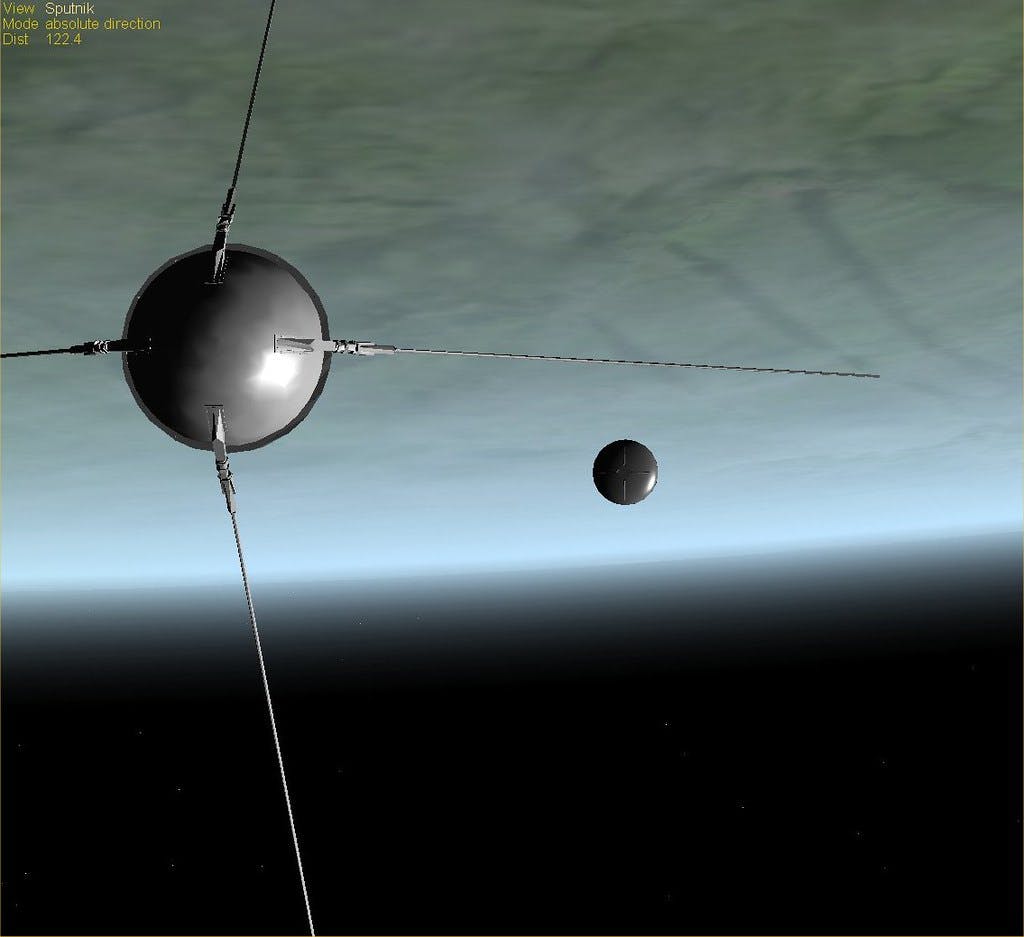Sputnik: The satellite spark that ignited the Space Race

Blog
On October 4, 1957 the world entered the Space Age as the USSR successfully launched “Sputnik I,” the first man-made satellite, into orbit. The 180-pound, pressurized spherical satellite was a bit larger than a basketball and simply broadcast its “beep, beep” radio signal back to Earth until its batteries ran out 23 days later, but its impact on the mindset of American citizens, the space race, and the arms race can hardly be overstated. In our modern world where tens of thousands of satellites orbit the planet, providing everything from crop and weather reports to military observation capabilities to streaming video services, a single, shiny aluminum ball in orbit going “beep, beep, beep” doesn’t sound like it could possibly disrupt much of anything, but remember that we’re talking about 1950s Cold War America here. The fuse of the 20th-century nuclear arms race was ready to be lit, and Sputnik provided the spark.

What was the purpose and impact of Sputnik?
The 5 stated scientific purposes of Sputnik I were: To test the method of placing an artificial satellite into Earth orbit; to provide information on the density of the atmosphere by calculating the satellite’s lifetime in orbit; to test radio and optical methods of orbital satellite tracking; to determine the effects of radio wave propagation through different parts of the atmosphere; and to check the principles of pressurization used on the satellite.
However, the launch of Sputnik, along with the successful August 1957 test of a Soviet ICBM and the launch of Sputnik II in November that year (which was the first successful insertion of a living thing—a dog in this case—into orbit) struck fear into the hearts of America and “the free world,” and brought immense pride to the Soviets. Since the end of WWII, the US had grown increasingly afraid of the spreading communist/Soviet threat, which was further intensified by the Korean War of 1950-53. The idea of a “commie” satellite orbiting in space, passing over the USA 7 times a day, sending radio signals to Moscow and doing who knows what, was intensely jarring to Mr. and Mrs. America.
Sputnik was visible in the night sky over the US, so it may have had a more intense psychological effect than it otherwise may have had. Furthermore, politicians and policymakers, as they tend to do, took advantage of the situation to create anxiety among Americans over a so-called “missile gap” between US and Soviet ICBM capabilities. Americans were shocked that their leaders had allowed the nation to fall so far behind their communist rivals in space technology, and policymakers capitalized on the fervor to accelerate spending on space and weapons programs.
The flames of the Space Race were fanned further by USSR premier Nikita Khrushchev, who bombastically boasted about his country’s technological superiority in space and his growing stockpiles of ICBMs aimed at free Europe and America. ArmsControl.org writes, “The shock of being bested in space by the United States’ superpower rival and the prediction . . . of future Soviet strategic advances set the stage for the appearance of the missile gap. A sense of alarm spread, along with a narrative that the Eisenhower administration had been complacent in the face of an acute military threat. Influenced by a combination of inadequate information and partisan political motives, Democratic politicians cultivated the notion that the aging incumbent had been asleep at the switch and that a new team was needed to reinvigorate government and restore US nuclear superiority.”
This situation, and the fear it spurred, was instrumental in John F. Kennedy’s defeat of Eisenhower’s Vice President, Richard Nixon, in the 1960 presidential election, as well as in the creation of NASA and the explosion in interest (and funding) for the US’s space program. Sputnik also delayed a potential ban on nuclear testing and development. The US Department of State’s Office of the Historian elaborates, “With both countries researching new technology, talk of creating a treaty banning nuclear testing faded away for several years. In this way, the launch of Sputnik fueled both the space race and the arms race, in addition to increasing Cold War tensions, as each country worked to prepare new methods of attacking the other.”
Without Sputnik, there would likely have been no President Kennedy, no Apollo missions, no Moon landings. Think about that.

What does Sputnik mean in Russian?
“Sputnik” means “fellow traveler” or “one who travels with another.” The apparent intent of this name for the satellite was to signify that Earth was moving through space (the traveler) and Sputnik was moving around the planet, also moving through space, or traveling along with it. However, “Sputnik” has since come to signify pretty much any space satellite in informal Russian, and of course “fellow traveler” ironically came to connote someone who sympathizes with the communist cause.

How many satellites are currently orbiting Earth?
It depends on whom you ask… and the number changes weekly. According to the Union of Concerned Scientists database, there were 5,465 satellites orbiting Earth as of May 2022. The United Nations Office for Outer Space Affairs (UNOOSA) says over 12,000 objects have been launched into space, with around 4,800 being currently active satellites. However, these numbers don’t take into account what’s happening in “NewSpace,” and the crazy-aggressive schedule of SpaceX’s Starlink launches. In 2022 alone, the Muskman launched around 1,775 “CubeSat” type Starlink satellites into low Earth orbit (LEO), and in 2023 has been keeping up an average cadence of one launch per week with 50+ satellites aboard each rocket, averaging over 200 new satellites in orbit per month—just from SpaceX’s Starlink launches and rideshares. The boring regularity and relative reliability and longevity of today’s low-cost satellites must have been the stuff of pure fantasy to the Sputnik scientists.
The upshot of all of this is that maintaining an accurate count of how many operating and non-operational satellites currently orbit the Earth is extremely difficult if not impossible, and once an accurate number is reached, it literally changes on a weekly basis. SpaceX has approval to launch 7,500 satellites to support its Starlink constellation and network, and it’s certain that the company is working on getting approval for more. Remember, this is just one company and doesn’t account for government satellites, weather satellites, or “legacy” telecom satellites (typically in high Earth orbit). In a very short number of years, Starlink alone could reach its stated goal of a 42,000-satellite “mega-constellation.” The days of the world being shocked and terrorized by a single Russian satellite are over (though we can still lose our minds about Chinese spy balloons).
Sputnik remained in orbit (but no longer broadcasting after its batteries died) until January 4, 1958, when it re-entered Earth’s atmosphere and burned up. It only survived for 3 months in orbit, but it helped set off the nuclear arms race and intensify the Cold War, whose impact on the American psyche continues to this day.
–By Jeff Davis, Intergalactic Scribe
Sources:
https://history.state.gov/milestones/1953-1960/sputnik
https://www.usnews.com/news/world/articles/2007/09/28/10-things-you-didnt-know-about-sputnik
https://www.nasa.gov/multimedia/imagegallery/image_feature_924.html
https://www.armscontrol.org/act/2011-05/missile-gap-myth-its-progeny
https://en.wikipedia.org/wiki/List_of_Starlink_and_Starshield_launches